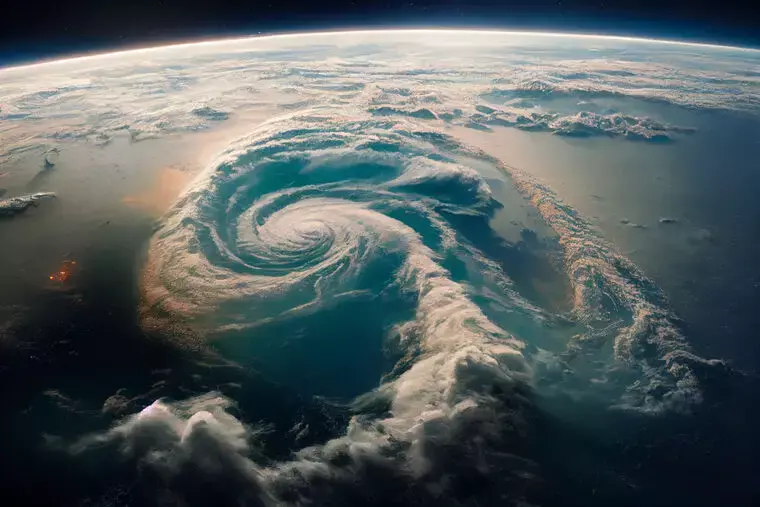A recent study by scientists from Lawrence Berkeley National Laboratory presents compelling evidence that the current Saffir–Simpson Hurricane Wind Scale, which classifies hurricanes up to Category 5, is no longer sufficient for the types of mega-hurricanes the world could soon start seeing.
With hurricanes reaching unprecedented intensities due to global warming, researchers say there’s a strong argument for introducing a new Category 6 classification.
“Both observations and models suggest that the open-endedness of the 5th category of the Saffir–Simpson hurricane wind scale becomes increasingly problematic for conveying wind risk in a warming world,” study authors write.
“Our motivation here is to reconsider how the open-endedness of the scale can lead to an underestimation of risk, and, in particular, how this underestimation becomes increasingly problematic in a warming world.”
Historically, the Saffir–Simpson scale has been instrumental in communicating the potential wind damage of hurricanes to the public. However, it caps at Category 5, which includes storms with wind speeds of more than 157 miles per hour.
Dr. Michael Wehner, a senior scientist in the Applied Mathematics and Computational Research Division at the Lawrence Berkeley National Laboratory, and climate scientist Dr. James Kossin say the Category 5 cap now fails to accurately represent the increased intensity and potential damage of the most mega-hurricanes in a warming world.
Researchers say extending the scale to include a Category 6—for storms with wind speeds exceeding 192 mph—will better convey the risks associated with the types of mega-hurricanes we will likely experience in the near future.
Study findings published in the journal PNAS-Environmental Sciences highlight a concerning trend of global warming significantly increasing the strength of the most intense hurricanes.
Using a blend of observational data, theoretical models, and climate simulations, researchers said evidence suggests future hurricanes are expected to increasingly surpass the Category 5 threshold.
According to the U.S. National Hurricane Center, 22 Category 5 hurricanes have occurred in the last 100 years. Nearly half (48%) of those occurred within the past 20 years.
In the last 10 years, several storms, including Typhoon Haiyan and Hurricanes Patricia, Haiyan, and Goni, all exhibited wind speeds exceeding 192mph, placing them within the researcher’s proposed Category 6.
And current climate projections suggest that such ultra-intense mega-hurricanes will only become more frequent as global temperatures rise.
The issue’s core lies in the fact that global warming is pumping more energy into the climate system, particularly the oceans, which serve as the engine for hurricanes.
Warmer ocean temperatures increase the latent and sensible heat for storm formation, leading to more powerful hurricanes. This phenomenon raises the peak wind speeds of these storms and increases their potential for destruction.
The recent study isn’t the first time climate scientists have kicked around introducing a new Category 6 mega-hurricane classification.
At a 2018 climate conference in New Zealand, climatologist and the director of the Earth System Science Center at Penn State University, Dr. Michael Mann, described the current Saffir–Simpson scale as increasingly outdated.
“Scientifically, [six] would be a better description of the strength of 200mph storms, and it would also better communicate the well-established finding now that climate change is making the strongest storms even stronger,” Dr. Mann said.
In a 1991 interview, meteorologist and co-creator of the Saffir–Simpson scale, Dr. Robert Simpson, said going beyond the maximum Category 5 is unnecessary because the scale was initially designed to measure property damage, not as a scientific barometer.
“When you get up into winds in excess of 155 miles per hour, you have enough damage [and] if that extreme wind sustains itself for as much as six seconds on a building, it’s going to cause rupturing damages that are serious no matter how well it’s engineered,” said Dr. Simpson. “I think that it’s immaterial what will happen with winds stronger than 156 miles per hour. That’s the reason why we didn’t try to go any higher than that anyway.”
Regardless of its original intent, many climate scientists like Dr. Mann, Dr. Wehner, and Dr. Kossin say today’s Saffir–Simpson scale is used for more than simply demonstrating a hurricane’s property damage potential.
“Since the scale is now used as much in a scientific context as it is a damage assessment context, it makes sense to introduce a category six to describe the unprecedented strength 200mph storms we’ve seen over the past few years,” Dr. Mann explained.
Given the system’s current use and the increasing intensity of modern storms, Dr. Simpson may have eventually warmed up to the idea of updating the scale he helped create. However, he passed away in 2014 at the age of 102.
Researchers say introducing a Category 6 mega-hurricane to the classification system is more than a technical adjustment. It’s a crucial step for public safety and awareness.
With storms growing stronger, researchers argue that current categorizations underplay the actual risk posed by the most severe hurricanes. They say a new category would better reflect the escalating hazard, helping to ensure communities are more appropriately prepared for the impacts of these supercharged mega-hurricanes.
The study’s authors advocate adopting a Category 6 classification to raise awareness and prompt action. They hope that recognizing the increasing intensity of storms will improve preparedness and response strategies, potentially saving lives and reducing damage.
The study also underscores the broader issue of climate change, highlighting the urgent need for global efforts to mitigate its impacts.
“Tropical cyclone risk messaging is currently a very active topic, and changes in messaging are widely believed necessary to better inform the public about inland flooding and storm surge, phenomena that a wind-based scale is only tangentially relevant to,” wrote study authors.
“While adding a 6th category to the Saffir–Simpson Hurricane Wind Scale would not solve that issue, it could raise awareness about the perils of the increased risk of major TCs due to global warming.”
Tim McMillan is a retired law enforcement executive, investigative reporter and co-founder of The Debrief. His writing typically focuses on defense, national security, the Intelligence Community and topics related to psychology. You can follow Tim on Twitter: @LtTimMcMillan. Tim can be reached by email: tim@thedebrief.org or through encrypted email: LtTimMcMillan@protonmail.com

